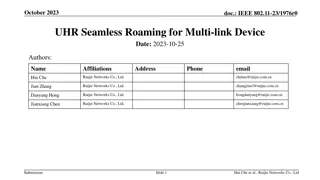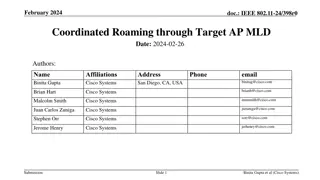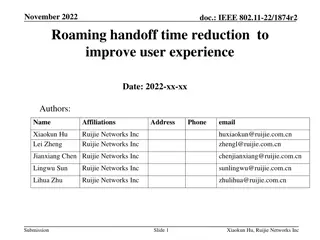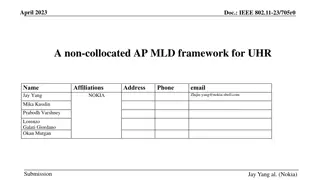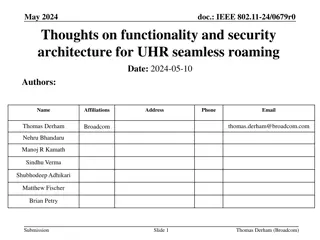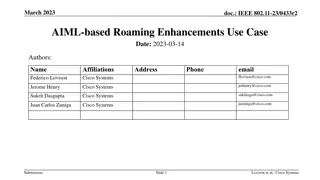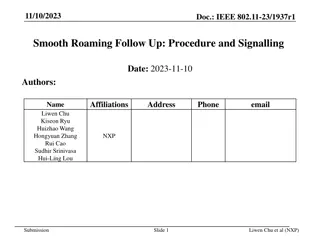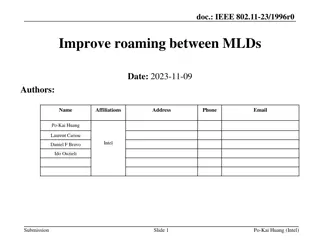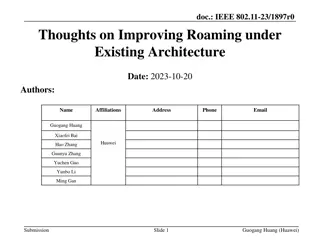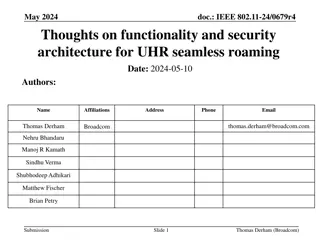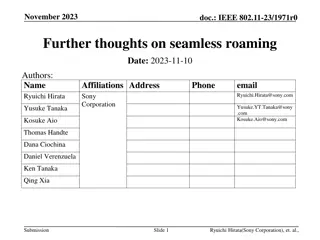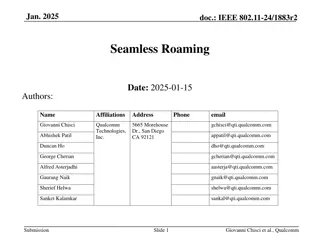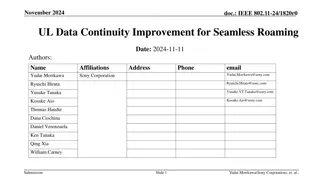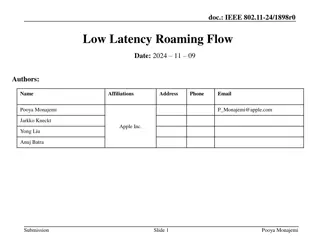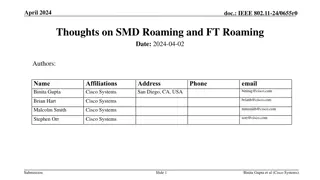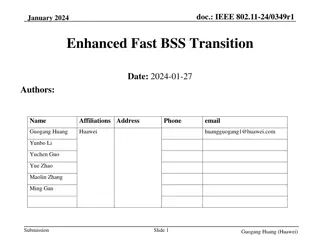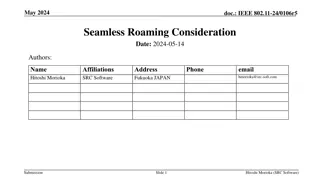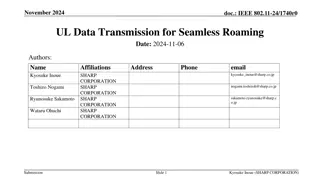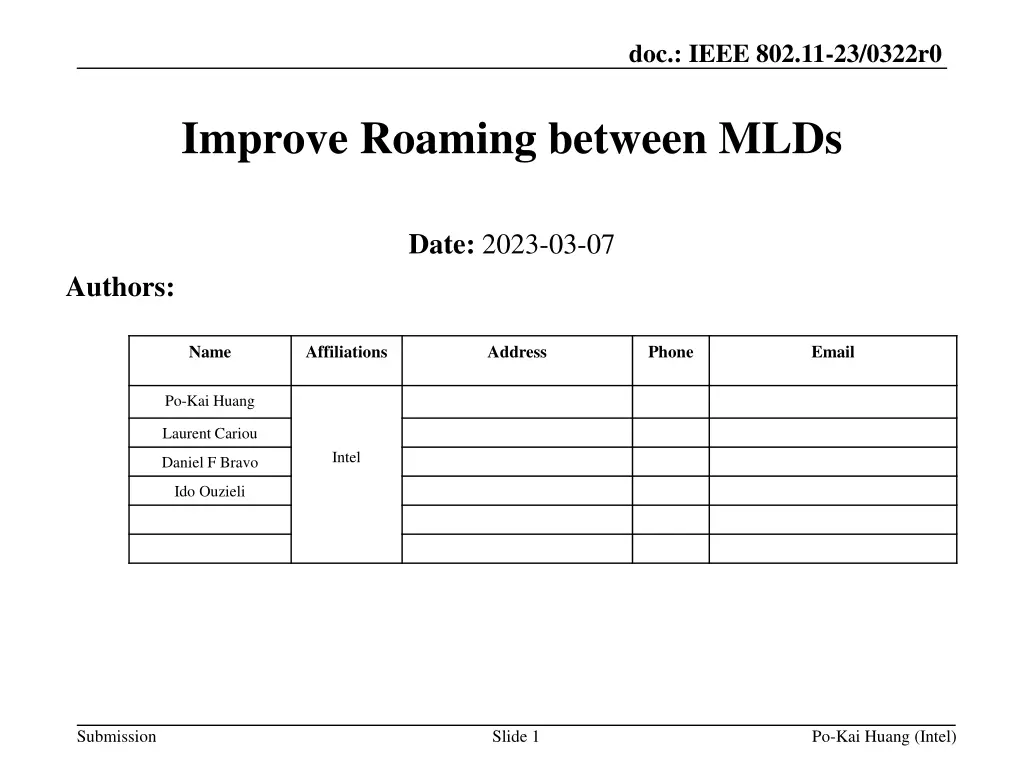
Improving Roaming Between MLDs for Enhanced WLAN Connectivity
Explore how IEEE 802.11-23/0322r0 aims to enhance roaming between MLDs to reduce latencies, increase manageability, and optimize data continuity. The proposal addresses design challenges, including the necessity for a new framework, data continuity considerations, and central receive reordering buffer implementation.
Download Presentation

Please find below an Image/Link to download the presentation.
The content on the website is provided AS IS for your information and personal use only. It may not be sold, licensed, or shared on other websites without obtaining consent from the author. If you encounter any issues during the download, it is possible that the publisher has removed the file from their server.
You are allowed to download the files provided on this website for personal or commercial use, subject to the condition that they are used lawfully. All files are the property of their respective owners.
The content on the website is provided AS IS for your information and personal use only. It may not be sold, licensed, or shared on other websites without obtaining consent from the author.
E N D
Presentation Transcript
doc.: IEEE 802.11-23/0322r0 Improve Roaming between MLDs Date: 2023-03-07 Authors: Name Affiliations Address Phone Email Po-Kai Huang Laurent Cariou Intel Daniel F Bravo Ido Ouzieli Submission Slide 1 Po-Kai Huang (Intel)
doc.: IEEE 802.11-23/0322r0 Abstract Goal of UHR: The Study Group will investigate technology which may improve reliability of WLAN connectivity, reduce latencies, increase manageability, increase throughput including at different SNR levels, and reduce device level power consumption. We discuss how to improve roaming between MLDs to reduce latencies and increase manageability Submission Slide 2 Po-Kai Huang (Intel)
doc.: IEEE 802.11-23/0322r0 How can we improve roaming between MLDs? Roam Existing roaming procedure: Authentication Association Key negotiation DS starts to forward data for transmission Frame exchange to do various setup There are existing methods to optimize some of the steps, but there are no existing methods to allow data continuity, i.e., without the need to flush data and restart To improve roaming, believe that the trend is to allow data continuity and continue to optimize the steps We discuss the critical design consideration of data continuity in this presentation. Current AP MLD Target AP MLD Submission Slide 3 Po-Kai Huang (Intel)
doc.: IEEE 802.11-23/0322r0 Caveat on the design ???? Current AP MLD Target AP MLD There have been naming discussion on the framework To start, two AP MLDs are required for legacy compatibility with EHT. Hence, can not simply merge existing AP MLDs EHT AP MLD requirements like STR, group addressed SN assignment and TSF requirements, etc will not work among two non-collocated AP MLDs and will not scall to all AP MLDs (100?) in an enterprise network Existing MLD framework can not be used without change. If we just discuss required functionalities, we need a new framework with right design of requirements that allow data continuity and control interactions among multiple AP MLDs to improve roaming. Submission Slide 4 Po-Kai Huang (Intel)
doc.: IEEE 802.11-23/0322r0 Data continuity consideration Unlike collocated APs for AP MLD, where received reordering buffer can be implemented locally within the AP MLD, there is a question on where to keep the received reordering buffer A cloud based received reordering buffer needs a lot of memory to keep the buffer for every non-AP MLD connects to the new framework Central Receive reordering buffer Current AP MLD Target AP MLD In practice, the receive reordering buffer will be in the edge like today, i.e., in either Current AP MLD or Target AP MLD. However, having transmission on both Current AP MLD and Target AP MLD means parameter sync and/or a potential long delay depending on the backhaul Current AP MLD Target AP MLD Central Receive reordering buffer Non-AP MLD Submission Slide 5 Po-Kai Huang (Intel)
doc.: IEEE 802.11-23/0322r0 Data continuity consideration For simplicity, we focus on transmission and operation to either current AP MLD or target AP MLD as a starting point, which does not need any instantaneous parameter sync Target AP MLD Current AP MLD Target AP MLD Current AP MLD Central Receive reordering buffer Central Receive reordering buffer Roam Non-AP MLD Non-AP MLD Realistic consideration and should be the first basic mode to be considered Submission Slide 6 Po-Kai Huang (Intel)
doc.: IEEE 802.11-23/0322r0 Data transfer consideration Current AP MLD Target AP MLD Current AP MLD Target AP MLD Current AP MLD Target AP MLD Roam and continue transfer Non-AP MLD Non-AP MLD Non-AP MLD Start transfer To achieve the basic mode, data needs to be duplicated and transferred from current AP MLD to target AP MLD before roaming Duplicate data is a heavy requirement Do not want to duplicate data to all other AP MLDs by default Need non-AP MLD to indicate when this is really needed to start the duplicate and transfer There can be optimization like transferring high priority TID first or pipeline operation, but this should be left for implementation specific consideration (spec does not define scheduling algorithm) When client wants to roam, client roams even when the data transfer is not finished and do not need to wait for a defined finish point Required functionalities: Have a method for a non-AP MLD to indicate that current AP MLD starts duplicate data transfer to target AP MLD Define contexts that can be preserved between MLDs Have a method for a non-AP MLD to switch data transmission and operation from current AP MLD to target AP MLD Submission Slide 7 Po-Kai Huang (Intel)
doc.: IEEE 802.11-23/0322r0 Conclusion We discuss how to improve roaming between MLDs by designing mechanisms to allow data continuity A new framework with right design of requirements that control interactions between AP MLDs is required to achieve data continuity We note that the proposed mechanism improves roaming but may not guarantee specific latency requirement for roaming like withing xxx milliseconds Exact performance depends heavily on backhaul capability (wireless/ethernet/fiber), roaming speed (client runs or walks), and scheduling algorithms to duplicate data The proposals introduce tools to improve roaming and have lossless operation (always) and seamless operation (when possible) Submission Slide 8 Po-Kai Huang (Intel)
doc.: IEEE 802.11-23/0322r0 Straw Poll Do you support to define a framework that controls interaction among multiple AP MLDs to improve non- AP MLD roaming between AP MLDs? Submission Slide 9 Po-Kai Huang (Intel)

